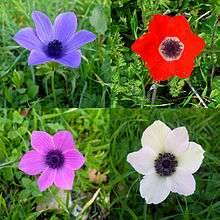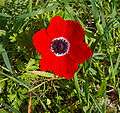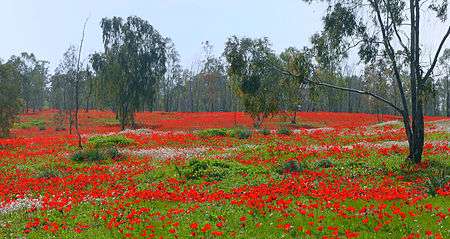Anemone coronaria
| Poppy anemone | |
|---|---|
 | |
| Scientific classification | |
| Kingdom: | Plantae |
| (unranked): | Angiosperms |
| (unranked): | Eudicots |
| Order: | Ranunculales |
| Family: | Ranunculaceae |
| Genus: | Anemone |
| Species: | A. coronaria |
| Binomial name | |
| Anemone coronaria L. | |

Anemone coronaria (poppy anemone,[1] Spanish marigold, dağ lalesi in Turkish, kalanit in Hebrew, shaqa'iq An-Nu'man in Arabic) is a species of flowering plant in the genus Anemone, native to the Mediterranean region.
Description
Anemone coronaria is a herbaceous perennial plant growing to 20–40 cm tall (rarely to 60 cm), with a basal rosette of a few leaves, the leaves with three leaflets, each leaflet deeply lobed. The flowers are borne singly on a tall stem with a whorl of small leaves just below the flower; the flower is 3–8 cm diameter, with 5–8 red, white or blue petal-like tepals.
Cultivation
Anemone coronaria is widely grown for its decorative flowers. Numerous cultivars have been selected and named, the most popular including the De Caen and St Brigid groups of cultivars.[2] The De Caen group are hybrids cultivated in the districts of Caen and Bayeux in France in the 18th century.
Etymology
Anemone coronaria means crown anemone, evoking regal associations.
The Arabic name is shaqa'iq An-Nu'man translated literally as the wounds, or "pieces", of Nu'man.[3][4] One possible source of the name traces back to the Sumerian god of food and vegetation, Tammuz, whose Phoenician epithet was "Nea'man".[5] Tammuz is generally considered to have been drawn into the Greek pantheon as Adonis, who died of his wounds while hunting wild boar. The deity is transformed into a flower, stained by the blood of Adonis.[5] Tammuz's Phoenician epithet "Nea'man" is believed to be both the source of "an-Nu'man" in Arabic which came through Syriac, and of "anemone" which came through Greek.[5] Another possible source of the name is An-Nu'man III Bin Al-Munthir, the last Lakhmid king of Al-Hirah (582-c.609 AD) and a Christian Arab. An-Nu'man is known to have protected the flowers during his reign.[3] According to myth, the flower thrived on An-Nu'man's grave, paralleling the death and rebirth of Adonis.
In Hebrew, the anemone is kalanit metzuya. "Kalanit" comes from the Hebrew word "kala כלה" which means "bride", "metzuya" means "common." The kalanit earned its name because of its beauty and majesty, evoking a bride on her wedding day.[6] In 2013 Anemone coronaria was elected as the national flower of the State of Israel, in a poll arranged by the Society for the Protection of Nature in Israel (החברה להגנת הטבע) and Ynet.[7]
Anemone coronaria grows wild all over Israel, Palestine and Jordan. During the British Mandate for Palestine, British soldiers were nicknamed "kalaniyot" for their red berets.
Gallery
-

-

Red Anemone coronaria
-

White Anemone coronaria
-

Purple Anemone coronaria
-

Anemone coronaria growing wild in Israel
-

Red Anemone coronaria with 6 petals
References
- ↑ "BSBI List 2007" (xls). Botanical Society of Britain and Ireland. Archived from the original on 25 February 2015. Retrieved 2014-10-17.
- ↑ BBC Gardeners' World Archived 11 July 2011 at the Wayback Machine.
- 1 2 Arabic-English lexicon, Volume 1, Part 4 By Edward William Lane, p. 1578, https://books.google.com/books?id=3p4OAAAAYAAJ&pg=PA1578
- ↑ The poetics of anti-colonialism in the Arabic qaṣīdah Hussein N. Kadhim, p. 158, https://books.google.com/books?id=80JtT6_MEmwC&pg=PA158
- 1 2 3 History of Syria: Including Lebanon And Palestine By Philip Khuri Hitti, p. 117, https://books.google.com/books?id=91YymsCw5DIC&pg=PA117
- ↑ Anemone coronaria in WildFlowers.co.il (Hebrew).
- ↑ הכלנית: הזוכה בתחרות "הפרח של ישראל", ynet, 25 November 2013.
External links
- Comprehensive profile for Anemone coronaria, MaltaWildPlants.com
- Anemonia coronaria in israelwildflowers.co.il
- Photos of Anemone coronaria on Flickr
- Anemone coronaria in Israel on Flickr
| Wikimedia Commons has media related to Anemone coronaria. |
